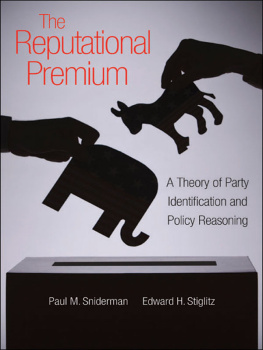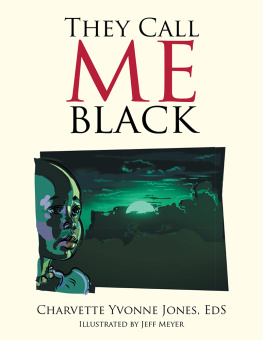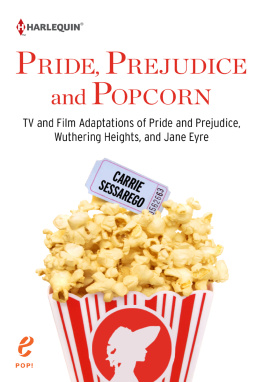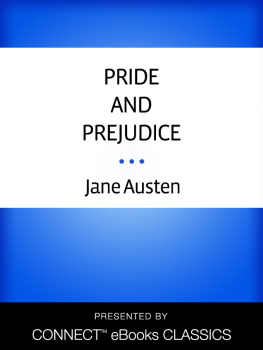Copyright 2002 by Princeton University Press
Published by Princeton University Press,
41 William Street, Princeton, New Jersey 08540
In the United Kingdom: Princeton University Press, 3 Market Place,
Woodstock, Oxfordshire 0X20 1SY
All Rights Reserved
Library of Congress Cataloging-in Publication Data
Sniderman, Paul M.
Black pride and black prejudice / Paul M. Sniderman and Thomas
Piazza.
p. cm.
Includes bibliographical references and index.
ISBN 978-0-691-12037-9
1. African AmericansRace identity. 2. African AmericansAttitudes. 3. PrejudicesUnited States. 4. United StatesRacerelations. I. Piazza, Thomas Leonard. II. Title.
E185.625 .S65 2002
305.896'073dc21 2002023661
British Library Cataloging-in-Publication Data is available
https://press.princeton.edu/
eISBN: 978-0-691-22561-6
R0

refaces are a way for a writer to speak informally to a potential reader, to say, Here is what I actually set out to do, what I really am trying to say. That is a bit of a problem for us. The issues we deal with invite misunderstanding. A sample: Does taking pride in being black lead black Americans to qualify their identity as Americans? Is there a problem of black anti-Semitism? If there is, is it tied in any significant measure to taking pride in being black? Does valuing being black encourage blacks to devalue those who are not black? If our answers to these questions are not clear and compelling, nothing we say here will excuse what we say later.
And there is another potential problem. Instead of just conducting a standard public opinion interview, our study carries out a number of custom-designed, randomized experiments. That is the strength of the study. Randomized experiments have an inferential power that no other procedure has, and many of our experiments the SAT experiment is a flagship exampleare original, allowing us to see some things that it has not been possible to see before. Yet there is good reason to be cautious about things being done for the first time.
We therefore have worked hard to test our findings. As a rule we designed and carried out experiments in pairs. For example, one question we investigated is whether black Americans are as willing to support policies like affirmative action when nonblacks are their beneficiaries as when blacks are. So we carried out a pair of experiments, one focusing on affirmative action for jobs, the other for congressional representation, each contrasting support for the policies when blacks benefit or when Mexican Americans do. Just so far as the results of the two experiments are similarand as it happens they are nearly identicalone can have confidence that the findings are reliable.
It was not always possible to conduct experiments in pairs. One experiment measures the readiness of black Americans to put considerations of race ahead of scores on achievement teststhe SAT experiment. We could do this once. We really couldn't do it twice.
So we have followed an additional strategy. Where appropriate we used measures from other studies. That means we not only asked about some of the same things but also asked about them in the same way. To be sure, our study mainly is about quite different things than previous studies of black Americans. They have concentrated on how blacks vote in presidential elections and what positions they take on issues of immediate relevance to black Americansfor example, whether government should work to improve the position of blacks. We concentrate on the readiness of blacks to embraceor to rejectother Americans and their own identity as Americans. But despite the difference in focus, we made sure in advance that our study's results could be compared with those of other studies at a number of points. And just so far as the results of our study and those of previous studies are similar, and they are, that is another reason for confidence in our results.
From a specialist's point of view, statistical analysis is of value, not because it allows precise judgments about the way things are, but because it lets us gauge the imprecision of our judgments. From an intelligent, but not technically trained, reader's point of view, statistics may be worse than useless because they can make what otherwise would be readily comprehensible incomprehensible. From our point of view, there is no point to our having done what we have done if readers cannot immediately understand what we have done. So we say what we have to say as forcefully as we can and show what we have found as clearly as we can, while supplying in separate "sidebar" boxes the technical details specialists require.
Every study has limitations, ours very much included. But we believe this study opens to view aspects of the beliefs and commitments of African Americans that hitherto have been out of sight. So far as we have succeeded, we have many to thank. The National Science Foundation funded all of the surveys we rely on: the Black Belief Study (SBR-942016), the second Multi-Investigator Study (SBR-9633743), and the National Race and Politics Study (SES-8821575). In addition, the Achievement Based Award (SES-0111715) assisted completion of the writing of this book. There are not many social scientists who have had the opportunities to carry out original surveys of the American public that we have had. We are deeply grateful to the political science program at NSF and its director, Frank Scioli.
Needless to say, the NSF and the political science program are not responsible for the design of the study itself or the conclusions we have drawn from it. Nor are any of the many colleagues who have read drafts of this book and made sure that we did not lack for critical suggestions. These include: Henry E. Brady, Edward G. Carmines, Josh Cohen, Darren Davis, James Gibson, Martin Gilens, Donald L. Horowitz, Tamar Jacoby, James H. Kuklinski, Arthur Lupia, Diana Mutz, Philip Tetlock, and Alan Wolfe. We are grateful to all of them. We owe, however, a singular debt to Martin Shapiro. Every writer deserves a reader like Martin. Few get them. We are also heavily indebted to Eugenia Guilmartin for crucial help in preparing the figures and tables for this book. As for our editor, Chuck Myers, we would capsize if we took on board our full debt to him. He has been our colleague and has become our friend. We are also grateful for the assistance of the Survey Research Center and its director, Henry E. Brady, and of the Stanford Institute for the Quantitative Study of Society and its director, Norman Nie.









 refaces are a way for a writer to speak informally to a potential reader, to say, Here is what I actually set out to do, what I really am trying to say. That is a bit of a problem for us. The issues we deal with invite misunderstanding. A sample: Does taking pride in being black lead black Americans to qualify their identity as Americans? Is there a problem of black anti-Semitism? If there is, is it tied in any significant measure to taking pride in being black? Does valuing being black encourage blacks to devalue those who are not black? If our answers to these questions are not clear and compelling, nothing we say here will excuse what we say later.
refaces are a way for a writer to speak informally to a potential reader, to say, Here is what I actually set out to do, what I really am trying to say. That is a bit of a problem for us. The issues we deal with invite misunderstanding. A sample: Does taking pride in being black lead black Americans to qualify their identity as Americans? Is there a problem of black anti-Semitism? If there is, is it tied in any significant measure to taking pride in being black? Does valuing being black encourage blacks to devalue those who are not black? If our answers to these questions are not clear and compelling, nothing we say here will excuse what we say later.










